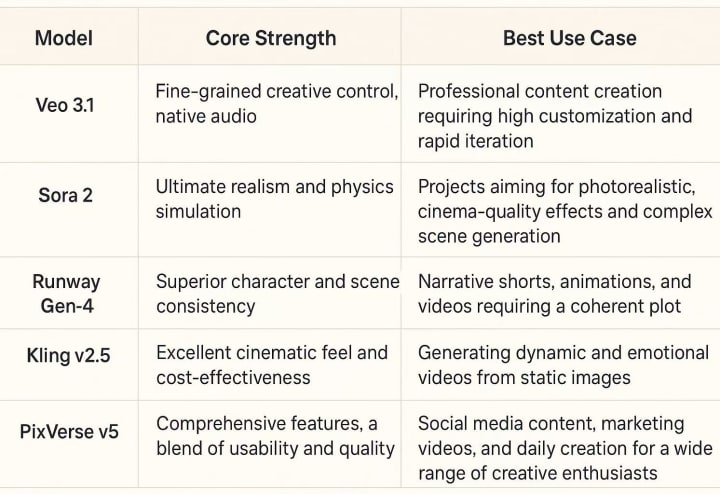A Deep Dive into the Top 5 Video Generation Models
This article provides an in-depth analysis of five of the most prominent video generation models on the market today: Veo 3.1, Sora 2, Runway Gen-4, Kling v2.5, PixVerse's v5, breaking down their features, strengths, and weaknesses.

At the forefront of the artificial intelligence wave, video generation models are evolving at an unprecedented pace, constantly redefining our understanding of content creation. From simple text prompts to lifelike videos, these models are ushering in a new era of infinite possibilities for filmmakers, marketers, and content creators.
1. Google Veo 3.1: The Master of Creative Control
Google's Veo 3.1, the latest iteration of its video generation model, is designed to provide creators with unparalleled granular control. It is more than just a simple text-to-video converter; it's a powerful platform for creative execution.
Core Features:
- Multiple Generation Modes: Veo 3.1 offers three generation modes, including structure-based, style-based, and pure text-to-video conversion, to meet diverse creative needs.
- Precise Shot Control: The "Start & End Frame Mode" allows users to generate coherent transitions by providing the first and last frames of a video. The "Multi-Image Reference Mode" can guide scene composition and subject consistency using multiple reference images.
- High-Quality Output and Audio Integration: It supports resolutions up to 1080p and video generation up to one minute in length, and can simultaneously generate rich ambient audio and sound effects, significantly improving creative efficiency.
Strengths:
- A high degree of creative freedom and fine-grained control.
- Strong prompt adherence and understanding.
- Native audio generation simplifies the post-production workflow.
2. OpenAI Sora 2: The Evolution of the "World Simulator"
OpenAI's Sora 2 represents a giant leap forward from its predecessor, aiming not just to generate videos, but to simulate a believable physical world.
Core Features:
- Highly Realistic Physics Simulation: Sora 2 possesses a deep understanding of the laws of the physical world, enabling it to generate complex scenes with accurate physical interactions and dynamic effects.
- Multimodal Input and Editing: It supports the generation of new video content from text, images, and even video clips, and features video-to-video editing capabilities.
- Audiovisual Synchronization and Stylistic Diversity: Capable of generating audio that is highly synchronized with the visuals and supports a wide range of artistic styles, from surrealism to anime.
Strengths:
- Industry-leading realism and physics simulation.
- Powerful scene understanding and multi-shot narrative capabilities.
- Maintains high consistency of characters and objects across different shots.
3. Runway Gen-4: The Solver of Narrative Consistency
Runway has long been a pioneer in the AI video creation space, and its Gen-4 model addresses a core pain point in AI video generation: consistency.
Core Features:
- Character and Scene Persistence: Gen-4's biggest breakthrough is its ability to maintain character and environment consistency across multiple shots and scenes, which is crucial for narrative content creation.
- Professional Creative Tools: It offers advanced camera controls, reference-based generation, and features that ensure temporal coherence, supporting professional film and video production workflows.
- User-Friendly Interface: Continues Runway's tradition of a clean and intuitive design, making it easy for even beginners to get started quickly.
Strengths:
- Successfully solves the long-standing issue of inconsistency in AI videos, enabling the creation of longer-form content.
- Focused on serving the film and creative industries with a comprehensive toolset.
4. Kling v2.5: The Creator of Cinematic Feel on a Budget
Launched by Kuaishou, the Kling v2.5 model has carved out a niche in the market with its excellent cinematic quality and cost-effectiveness, performing particularly well in image-to-video generation.
Core Features:
- Cinema-Grade Visuals: Kling v2.5 excels at generating cinematic video clips from static images, featuring rich dynamics, nuanced emotions, and stable styles.
- Precise Motion Capture: The model performs exceptionally well in terms of motion fluidity and the subtle changes in character expressions.
- Flexible Parameter Control: It supports long text prompts, complex camera movements, and offers advanced features like negative prompts and CFG Scale Control, giving creators more precise control over the final output.
Strengths:
- Excellent motion fluidity and realistic character expressions.
- Maintains stable style and color throughout the video.
- Offers a higher cost-performance ratio compared to models with similar effects.
5. PixVerse v5: The Versatile and User-Friendly Creator Platform
PixVerse v5 is a versatile video generation platform aimed at a broad range of creators, striking a fine balance between ease of use and professional-grade output quality.
Core Features:
- Multimodal Input and Fusion: It supports text, single-image, and even multi-image inputs, with a unique "Fusion" feature that can merge up to three images into a single video.
- Excellent Motion and Visual Performance: The v5 version shows significant improvements in motion quality, visual effects, and prompt accuracy, capable of generating smooth, clear, and cinematic footage.
- Rich Style and Format Options: It offers a variety of artistic styles (such as anime, 3D animation, etc.) and supports resolutions up to 1080p, with the ability to upscale to 4K.
Strengths:
- Fast rendering times and high iteration efficiency.
- Combines ease of use with high-quality output, making it suitable for a wide user base.
- Comprehensive features that can meet various needs, from social media content to marketing ads and creative storytelling
Conclusion and Outlook

The field of video generation models is currently experiencing a renaissance. Whether it's Sora 2's pursuit of ultimate realism, Veo 3.1's empowerment of creators with maximum control, or Runway Gen-4's solution to the consistency puzzle, each model is pushing the boundaries of creativity in its unique way. For content creators, this is undoubtedly an exciting time. Choosing the right tool for their needs to transform imagination into visual masterpieces is no longer a distant dream. In the future, we can reasonably expect these models to become even more powerful, user-friendly, and deeply integrated into every aspect of content creation.














